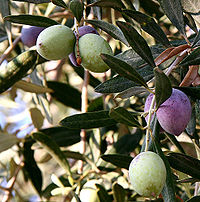
Photo from wikipedia
AbstractIn the last years, the spread of wilt and dieback diseases in olive trees (Olea europaea), caused by the soilborne pathogens, has often been related to intensive modern farming of… Click to show full abstract
AbstractIn the last years, the spread of wilt and dieback diseases in olive trees (Olea europaea), caused by the soilborne pathogens, has often been related to intensive modern farming of highly productive cultivars, planted at high densities, usually in an irrigated system. Plants have developed different strategies to trigger defense signaling to defend themselves and to maintain surveillance against pathogens. However, the response of olive tree to pathogen infections is not well studied yet. The present work is aimed at studying the response of olive tree to soilborne fungi isolated from different affected areas in Tunisia, such as Fusarium spp., Verticillium dahliae, Cylindrocarpon sp. and Rhizoctonia solani. Artificial inoculation on young olive trees cv. ‘Chemlali’ confirmed the pathogenicity of all these pathogens by reproducing typical symptoms of root rot with varied degrees. Biochemical analysis realized after 21 days of inoculation has shown that chlorophyll pigments, solubles sugar, total polyphenols and proline contents were highly detected in plants infected by V. dahliae and F. solani. The expression of four genes Olest 06, Olest 47, Olest 73 and Olest 30 involved in the signaling biotic and abiotic stress and transcriptional activation of pathogenesis-related proteins was analyzed by reverse transcription-PCR after 21 days of inoculation. The transcript level of Olest 73 was relatively constant in all tested fungi. The expression of gene Olest 47 was observed in the leaves of olive in vitro plants infected by V. dahliae and Fusarium spp., and the gene expression of Olest 30 was detected only in plants infected by V. dahliae. No PCR product was detected for Olest 06 in all inoculated olive trees. In conclusion, according to results obtained by biochemical and molecular analysis, the olive trees develop variable responses to pathogenic soil fungi attack.
Journal Title: Journal of Plant Diseases and Protection
Year Published: 2017
Link to full text (if available)
Share on Social Media: Sign Up to like & get
recommendations!